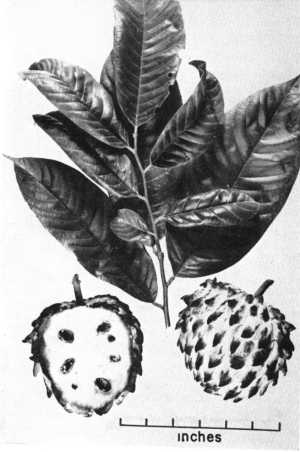Sunset®: 24-25
USDA: 10-11
Frost Tolerance: Tender in Phoenix, foliage damaged at 30° F (-1° C), serious damage at 26° F (-3° C)
Sun Exposure: Full sun to light shade
Origin: Central America
Growth Habits: Small deciduous tree, up to 20 feet tall (6 m)
Watering Needs: Regular water
Propagation: Seeds, budding, grafting
The Sweetsop is a small deciduous tree that rarely reaches a height of more than 20 feet. The 8- to 10-inch leaves are usually lanceolate to oblong-lanceolate. This species probably is indigen ous to the warmest part of Central America and grows best in the warm dry areas of the Tropics.
Fruiting Habits:
The fruit, which ripens in the spring, is subglobose or ovoid. I is composed of loosely cohering carpels which are usually covered with a white or bluish bloom. The carpels separate readily when ripe, exposing the cream colored flesh in which are imbedded numerous small brown glossy seeds. The fruit pulp has a custard consistency and is sweet and pleasant tasting. The pulp usually is eaten fresh as a dessert fruit, but it is also used to make a delicious sherbet. The sweetsop is of better quality than the custard apple and deserves to be more widely planted in the Tropics. If allowed to ripen fully on the tree the fruits split open. Such losses can be prevented by picking the fruits before they reach this stage and allowing them to ripen off the tree.
Propagation:
As with the other annonas, the sweetsop often is grown from seeds. Such seedlings usually come into bearing when 3 to 4 years of age. Improved selections can be propagated readily by grafting or budding.
Desert-Tropicals is dedicated to provide gardening advice, gardening ideas, and information about flower of all kind for landscape and collections.We try to check carefully the identification of the plants on the illustrations as well as the other information from the page, but occasionally errors do occur. if you notice anything that needs to be changed please contact us.Thanks.
© 1998-2020 Philippe Faucon, All Rights Reserved.
